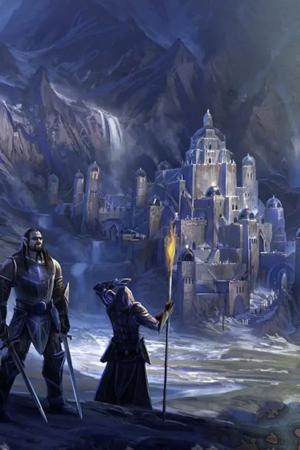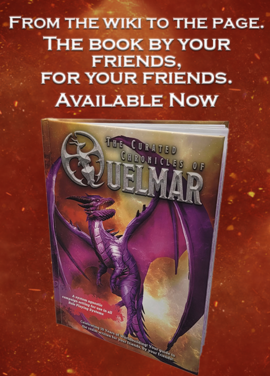| Years Active | Prehistory |
|---|---|
| Government | Tribal Confederacy / Monarchy |
| Enemies | Elven Kingdoms |
| Primary Race | Orcs |
Ogrund was a rare example of a unified Orcish nation; a formidable city built against the mountains of Osugbo during the Prehistory Era. It's history was mostly told through the legends and fables passed down through Orcish tribes, however its existence was hotly debated by scholars throughout the BR Era.
History[edit | edit source]
Many of the Orcish legends of this era tell the story of Tarok Bo'Gruum, the leader who united the Orcish tribes and founded the city of Ogrund.
Background[edit | edit source]
Ogrund's story begins following the Orc Purges, when the Elves of Isonhound sought to hunt down and remove what they viewed as brutish, uncivilised invaders from their continent. Over the course of several years the tribes scattered; their populations diminished and weakened to a fraction of their previous numbers. In the face of total annihilation, the leader of the Jartuun Tribe, Tarok, sought to unite their broken people and lead them to safer lands.
The exodus of the Orcs across the sea to Osugbo has been found depicted in a substantial collection of cultural artifacts from across the Prehistory Era. The image of their makeshift flotilla remained prevalent in the cultural identity of the Orcish people even long after the estimated fall of Ogrund.
On reaching the shores of Osugbo the orcs founded their first settlement, and it was here the tribal leaders bestowed upon Tarok the name Bo'Gruum: the Will of Gruumsh. This settlement would be short lived however, with constant attacks of ferocious beasts and innumerous Goblin hordes forcing the Orcs to move on after several months. This pattern continued for some time before the site of Ogrund was discovered.
First City[edit | edit source]
The city was finally founded in the mountainous forests of north west Osugbo. There was ample room for expansion, and resources aplenty. Tarok worked with the tribal leaders to develop and support their people. For the first time in memory the Orcs were able to live in peace without relying on raiding and destruction, however it was a difficult transition for some tribes to begin with. Over the years the plains and forests allowed agriculture to flourish amongst several of the tribes, whilst others turned to the mountains whose rich ores fueled the Orcish forges. The smiths of the realm were able to create not only beautiful and powerful weapons - such as The Gift of Gruumsh; a magical greataxe wielded by Tarok themself and said to be blessed by the Orcish god - but also tools and decorative works of art. Several examples were discovered deep in the halls of the Steelhand Dwarves, which have led scholars to believe that trading between the two races occurred for some time.
The first significant threat to the city was described in the tales depicting Tarok’s death. An army of Elves led by Lord Lúron Gruithor marched upon the city, seeking to finish the work they started decades before. It is said that all the people Ogrund took up their weapons and whatever tools to once again stand behind Tarok as they lead the charge against the aggressors, valiantly defending their home as Tarok and Lúron fought each other in single combat. The two warriors clashed in a long grueling melee, resulting in the inevitable deaths of both leaders where they were said to be found collapsed in each other’s arms. Following their death, the remainder of the Orcish people rallied behind Tarok’s child - Tesk - as they routed the Elven forces and protected the city. Tesk too took up the Bo’Gruum name and led the tribes of the city, which was said to have stood for “many generations” more.
The city’s eventual fall came about once again from invading Elves, this time with the support of Dwarven forces. The circumstances of this alliance have been lost to time, however they were successful in sacking the city and scattering the population. The Orcish people returned to their nomadic ways as the tribes went their separate ways across the realm.
Second City[edit | edit source]
There was at some point an attempt at creating a second Ogrund by an orc originally known as Kertak, who claimed to be the reincarnation of Tarok Bo’Gruum. They claimed that Gruumsh offered them a vision, guiding them to the ruins of Old Ogrund and commanding them to unite and strengthen the Orcish tribes again to enact revenge on the Elves and Dwarves. Many tribes - having reverted back to their more classic violent ways - were swayed by the bloodthirsty rhetoric and congregated on the site of the old city.
For a time the horde of orcs were successful in raiding the surrounding lands and rebuilding the ruins. However, Kertak’s increasing religious fervour and despotic madness further weakened the already tenuous support of the tribal leaders. Infighting became common as leaders attempted to show their strength over the other tribes. The city’s fall came from within as this conflict escalated to all out civil war between all the tribes in the streets. Ketrak ordered their zealous warriors to slaughter all who opposed them where they stood; the streets would run red and the entire city would burn.
Important Locations[edit | edit source]
Gornhold Keep[edit | edit source]
The impressive palace represented unity for the Orcish people. Entering through the main door, visitors would find themselves in the Hall of Vision: a long corridor whose walls were adorned with the sarcophagi of leaders from all the tribes. At the end lay the tomb of Tarok Bo’Gruum, flanked on either side by stairs leading to the throne room.
Dominating the centre of this room was a large wooden table, said to have been crafted from the ships that brought the Orcs to Osugbo. It was here the tribal leaders would meet and govern the city and their people. Large archways looked out over the city to serve as a reminder of everything they’d achieved together, and with whom their loyalties and obligations lay.
Temple of Gruumsh[edit | edit source]
A large imposing building halfway between the main city gate and the keep, this was the centre of worship to the Orcish deity. It housed a grand statue of the god as well as a large number of sacred artifacts. Principle among the collection was The Eye Of Gruumsh. Some theologian scholars have debated whether this referred to the physical preserved eye Gruumsh, lost in battle with Elven god Corellon, or - if they refuted that tale - whether it was an intricately decorated and jeweled idol representing the only eye Gruumsh ever had.
The Hearth Forge[edit | edit source]
In the centre of the lower trade district was the Hearth Forge, a large bustling communal space full of the city’s blacksmiths. Were it not for the spread of the impressive craft work produced here across the realm, the validity of the city’s existence would be far easier to debate. The surrounding mountains provided the crafters with an endless supply of good quality ores to work with, with an early form of steel being developed through bone rituals in the smithing process.



